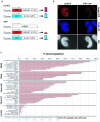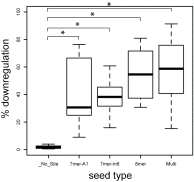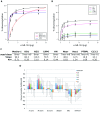Properties and kinetics of microRNA regulation through canonical seed sites
- PMID: 25870651
- PMCID: PMC4377283
Properties and kinetics of microRNA regulation through canonical seed sites
Abstract
MicroRNAs are a fundamental class of small RNAs involved in post-transcriptional gene regulation; however, the mechanism by which microRNAs regulate their gene targets in animals remains poorly understood. Practically, a mechanistic understanding of microRNA binding and regulation is crucial for the rational design of microRNA-based vectors for RNA interference. In this report, we focus on the largest known class of microRNA targets, the canonical seed targets, and explore the factors involved in modulating target downregulation in vivo at the protein level. Using an in vivo sensor assay in the ascidian Ciona intestinalis, we quantify miR-124-mediated downregulation of 38 canonical seed targets cloned from the Ciona genome as well as 10 control non-targets. Supporting previous findings, we observed that the seed type and number of seed sites are correlated with downregulation. However, up to a 50% variation in downregulation levels was observed for targets within the same seed class, indicating a role of non-seed factors in modulating downregulation. Although we did not observe a significant correlation of previously reported non-seed determinants with downregulation levels at saturation in our assay, our data suggest that two previously identified factors, secondary structure and 3'end complementarity, may play a role in the initial kinetics of microRNA-target binding. Importantly, using different concentrations of miR-124 we show that dose-dependent target downregulation profiles follow Michaelis-Menten kinetics. In summary, our findings emphasize the importance of non-seed factors as well as the importance of cellular concentrations of microRNAs relative to their targets when studying the mechanisms of endogenous microRNA regulation.
Keywords: Michaelis-Menten; canonical target; miRNA targets; microRNA; seed site.
Conflict of interest statement
None declared.
Figures



References
Grants and funding
LinkOut - more resources
Full Text Sources
